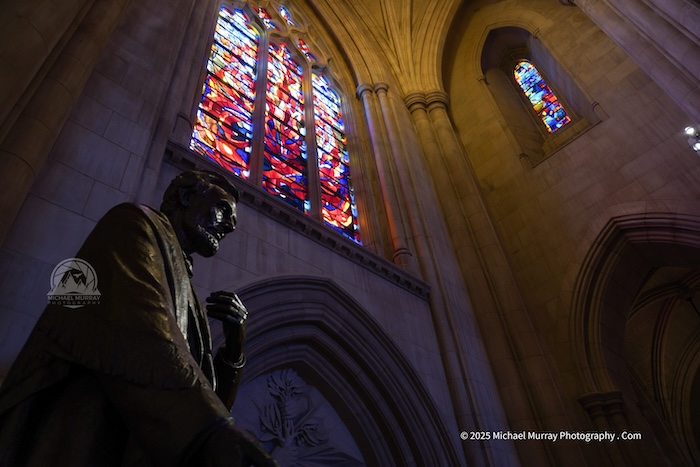Walter Hancock Statue of Abraham Lincoln Statue in the Washington National Cathedral
Bronze Artwork Photo in a Nave
Add this picture to your home or office decor.
High resolution image is available in multiple sizes (no watermarks). Interested? Please email me at [email protected]

When you gaze upon this photograph of Abraham Lincoln within the soaring nave of Washington National Cathedral, you’re seeing more than a static bronze figure — you’re witnessing a dialogue between light, stone, history, and memory. The statue, in fact, was dedicated in 1984, and is prominently placed on the south side of the nave (left of the main entrance).
Walter Hancock’s depiction is especially evocative: it shows Lincoln in 1861, as president-elect, draped in one of his signature shawls, poised to depart his hometown of Springfield, Illinois. Behind the bronze form is a wall inscribed with his Farewell Address, in which he entrusts his friends and neighbors to God and humbly asks them to pray for him as he journeys forward.
In this photograph, the sense of sacred space is palpable. The Cathedral’s Gothic-inspired walls rise vertically, the lines converging overhead, and its stained-glass windows filter daylight into delicate color washes. The light falls selectively: parts of Lincoln’s face — especially the ridge of his nose, the brow, the curve of his cheek — catch warm highlights. His outstretched hand, the drapery of his shawl, the folds of his coat, and the texture of the bronze all receive stray glimmers or recess into shadow. These contrasts of illumination and shade sculpt his presence, giving the statue a nearly living depth.
The walls and glass behind him contribute their own luminous character. You can see shafts of light dancing across stone surfaces and filtering through glass panes—some areas radiant, others muted. The architectural ribs, the tracery of window mullions, the vertical buttresses, all become part of the composition. The Cathedral’s ambiance becomes a co-author of the image: you sense both reverence and drama.
Part of the emotional power lies in the relationship of Lincoln’s figure to his surroundings. He is not hewn in isolation, but in conversation with the space: the soaring columns, the vaults, the light that washes past him and over him. The statue is not monumental in a heroic, overpowering sense; rather, it is humble, dignified, intimate — a man about to depart, mindful of his burden. That mood is heightened by the selective lighting in the photograph, which draws your eye to key parts of his face, hand, shawl, and posture.
Owning this photograph gives you a window into something few get to experience in person: the visual poetry of Lincoln’s statue set within the sacred geometry of the National Cathedral. The etched dedicatory inscription, though not fully visible in this frame, resonates behind the image:
“Abraham Lincoln whose lonely soul God kindled is here remembered by a people their conflict healed by the truth that marches on.”
And the Farewell Address inscribed on a wall just behind the statue — commending trust in God, humility, and prayer — casts an unseen halo of meaning over this artistic moment.
For collectors of historical photography, Lincoln aficionados, or admirers of fine architectural art, this image offers something rare: a moment of light dancing across bronze and stone, capturing Lincoln not in monumentality alone but in poised humanity, within a cathedral that itself aspires to transcendence. This photograph is not just a visual record; it is a meditative encounter.